It’s a well-known fact of any workplace: when managers don’t manage, some people quit, others are fired, company culture declines and output plummets.
We’ve all done our fair share of venting over second-rate managers at the dinner table. The complaints all go something like this: “I can’t work with her breathing down my neck,” “I’m just a number to him, someone enabling him to achieve his dreams” and “She never tells me what she expects, and now she’s writing me up for not doing my job. There’s only so much more of this I can take.”
Yet it’s little wonder that new managers flail and fall flat on their faces. For years, they excel in one position, and then one day turn around in a swivel chair to face a completely new set of responsibilities. –As managers don’t fulfill one single role, but rather a multitude of them.
The responsibilities of the position include coaching, leading, listening, communicating, hiring, motivating, incentivizing, setting clear expectations, giving critical feedback, structuring work and breaking down problems.
Many new managers have zero experience in any of these skills: and companies chronically fail to offer training in any of them!
If you’ve been promoted to manage a team, and in your paltry orientation you were simply handed a stack of files, shown to a desk and pointed in the general direction of the new team, then you’re probably drowning in everything you have to learn.
Fortunately, there are plenty of life rafts to climb onto. If you aspire to build an amazing culture, create innovative products and enable others, then tap into some of the best books for first-time managers.
The lessons and takeaways these experts relay show you a path to being not just a good manager, but a great manager who wins over a team and generates the momentum to rally success.
The Making of a Manager: What to Do When Everyone Looks to You by Julie Zhuo
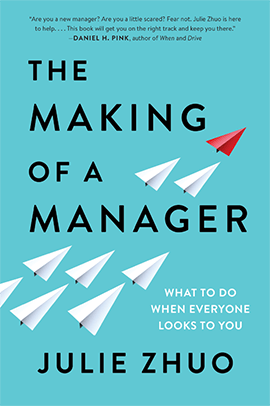 Publisher: Portfolio Penguin
Publisher: Portfolio Penguin
Year Published: 2019
Number of Pages: 288
For any newbie manager who’s bumbling around in the position, it can be such a relief to peek behind the curtain of someone who’s walked the same path before.
Julie Zhuo began managing at the ripe age of 25. In her engaging book, The Making of a Manager, which earned her a spot on the Wall Street Journal Bestseller List, she relates her own experience of growing into the role of VP of product design at Facebook.
Her understanding evolved from thinking that management is about having meetings and figuring out who should be promoted and fired, to realizing that it’s more about building a team, empowering, coaching and streamlining processes.
Zhuo asserts that managers are made, not born. In order to manage well, it’s necessary first to break away from any false ideas about the role, and understand what it’s really about.
“Management has nothing to do with employment status and everything to do with the fact that you are no longer trying to get something done by yourself.”
The measure of a good manager isn’t in how well he or she is liked, but in the quality of the team’s output.
“Your role as a manager is not to do the work yourself, even if you are the best at it, because that will only take you so far. Your role is to improve the purpose, people, and process of your team to get as high a multiplier effect on your collective outcome as you can.”
Zhuo organizes her book into ten chapters, with simple titles that include: “Amazing Meetings,” “Leading a Small Team,” and “Your First Three Months.”
She relates anecdotes of starting out at Facebook back when it was more of a “loose collective” and there weren’t any managers at all. Although the stories include many practical takeaways, they aren’t bulleted or codified, but simply stated within the text.
Zhou was born in Shanghai and graduated from Stanford. Currently she is the co-founder at Inspirit.
Readers appreciate how Zhou made herself vulnerable and benefit from reading about her evolution as a manager. Some found that the lessons were more applicable to management within high-growth tech companies, and not within smaller companies.
Wait, I’m the Boss?!?: The Essential Guide for New Managers to Succeed from Day One by Peter Economy
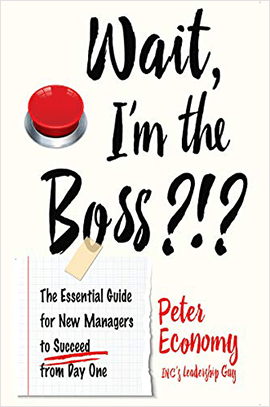 Publisher: Career Press
Publisher: Career Press
Year Published: 2020
Number of Pages: 208
What if you brought someone on board in your company, then waited an entire decade to finally train them in the duties of the role?
This sounds absurd, but, according to Peter Economy, author of Wait, I’m the Boss?!?, this is how things generally roll with managers. Only after a decade of working in the role do companies provide training!
His book speaks to new and current untrained managers, particularly in “new” work environments, which he defines as those impacted by evolving technology and changing demographics. It’s a how-to manual, the guide they’ll never receive in the workplace.
“So what can you do if you’re a new manager who hasn’t been offered any training in how to lead or be a manager? Read this book. And then put what you’ve read into practice….This book is a complete guide to all the things you need to know as a manager.”
The book first breaks down the role of manager, then covers managerial skills and challenges. It includes chapters on hiring and retaining, delegating, and coaching and mentoring, with titles such as: “Surviving Politics and People” and “Uh-oh—Dealing with Employee Problems.”
The book’s clear presentation and friendly tone make it a fun read. He begins each chapter with a quote, such as John Maxwell’s, “To add value to others, one must first value others.” The formatting includes headings and subheadings that make it super easy to capture key ideas.
In his career as a writer, Economy has ghostwritten 125 books! He also wrote the bestselling book, Managing for Dummies, and has published over 1,200 articles at Inc.com. He earned an economics degree at Stanford.
Readers find the principles in the book apply to any managerial position, and that it’s excellent for anyone wanting to level up as a manager. It’s easy to skim for takeaways, or to read all the way through.
The First 90 Days: Proven Strategies for Getting Up to Speed Faster and Smarter by Michael D. Watkins
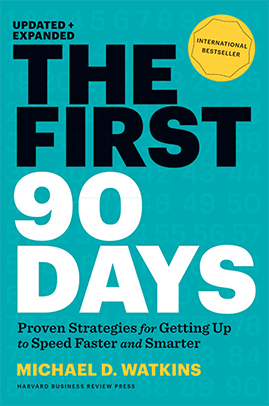 Publisher: Harvard Business Review Press
Publisher: Harvard Business Review Press
Year Published: 2013
Number of Pages: 304
“Every successful career is a series of successful assignments, and every successful assignment is launched with a successful transition,” writes Michael D. Watkins in his bestselling book, The First 90 Days.
Transitions are the most difficult part of any career. To succeed in a new role, the first 90 days must be approached strategically.
Watkins’ book speaks to managers heading up the chain of command, and provides a blueprint for creating the momentum necessary to catapult a new assignment.
“Opinions of your effectiveness begin to form surprisingly quickly, and, once formed, they’re very hard to change. If you’re successful in building credibility and securing wins, the momentum likely will propel you through the rest of your tenure. But if you dig yourself into a hole early on, you will face an uphill battle from that point forward.”
The First 90 Days covers specific lessons in how to avoid transition traps and create positive momentum. They include: preparing yourself, accelerating learning, securing early wins, negotiating success, building a team and accelerating everyone.
Watkins makes it easy for managers to apply the lesson to their situation. The book also includes helpful checklists for things like acceleration, alignment, early wins, onboarding, self-management and teams.
This book is quite a phenomenon. It’s sold over a million copies, has been translated into 24 languages and is included in Amazon’s 100 Top Business Books. The Economist named it “the onboarding bible.” The First 90 Days also has a YouTube channel and FaceBook page.
Currently, Watkins works as a coach to executives.
Readers find the book’s advice helpful, if not groundbreaking. It’s particularly beneficial for people newly appointed to senior management positions. The presentation makes the lessons easy to digest.
The Effective Manager by Mark Hortsman
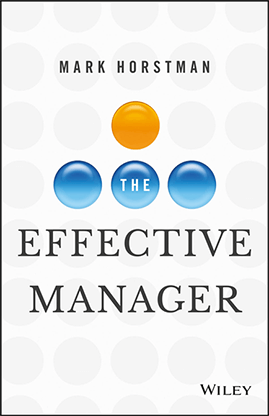 Publisher: Wiley
Publisher: Wiley
Year Published: 2016
Number of Pages: 208
“People are messy,” Mark Hortsman observes in his book, The Effective Manager.
This makes managing super tricky. There is no one single formula or metric for mastering the skill of overseeing and leading a team of diverse individuals. And since little training is provided, most managers perform rather poorly.
“Most managers are terrible at the most important thing they’re supposed to be doing: getting top performances out of the people they are managing.”
He calls his book a training guide and addresses it to managers in any field: sales, engineering, marketing, operations, logistics and software development. He asserts that managing fundamentally is about behaviors that can be taught.
“Success at work is about what you do—you are your behaviors. Almost nothing else matters.”
The first objective of any manager is to deliver the expected results. The second is to retain people. His guide provides a step-by-step plan to retain, coach, empower teams and improve output.
Hortsman wrote his book in conjunction with his popular podcast, Manager Tools. He also runs a company with the same name, providing conferences and coaching in manager training.
The book is organized into 14 chapters, the majority of which cover coaching, delegating, giving one-on-ones and providing feedback.
His clear lessons include personal stories and clever insights such as “The plural of anecdote is not data.”
Hortsman began his career in the military, and studied mechanical engineering at West Point. He provides training sessions to tens of thousands of managers each year.
His podcast fans found that The Effective Manager provides an excellent compilation of all the lessons from the podcast. However, some wish it included specific steps for implementing the lessons.
HBR’s 10 Must Reads for New Managers by Harvard Business Review
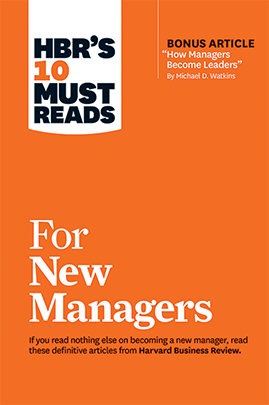 Publisher: Harvard Business Review Press
Publisher: Harvard Business Review Press
Year Published: 2017
Number of Pages: 224
Harvard Business Review’s 10 Must Reads for New Managers compiles into one simple volume some of the most incisive contributions in the area of new management. It’s the créme for advice on the topic.
Anyone new to management has a lot to learn, and these articles offer insight into an array of topics, including: time management, rapport building, delegation, leadership, transitions for managers, constructive feedback and change management.
The articles are written by thought leaders in business and marketing. They include: “Becoming a Boss” by Linda A. Hill, “Harnessing the Science of Persuasion” by Robert Cialdini, “Managing Your Boss” by John J. Gabarro and John P. Kotter and “What Makes a Leader” by Daniel Goleman.
The writing is scholarly and dense, and not surprisingly many of the authors, if not all, work as professors.
Each article has been formatted for easy browsing, and feature summaries, bulleted sections that recap key ideas, sidebars that tease out key messages and boxes that demonstrate what the concepts look like in practice.
The guide also includes a six page index, which makes it easy to ferret out specific topics quickly.
The Harvard Business Review is an authority for sound business advice. It creates digital content, as well as publishes a magazine and books through HBR press. This book is part of HBR’s “Must Read” Series, which also includes the topics: Emotional intelligence, Innovation, Leadership, Managing People and Collaboration.
Readers find that the articles cover classic managerial lessons, which are helpful for anyone who’s thrown into managing with no training. However, many articles present worst case scenarios, and so the tone isn’t always encouraging or empowering for new managers.
Welcome to Management: How to Grow From Top Performer to Excellent Leader by Ryan Hawk
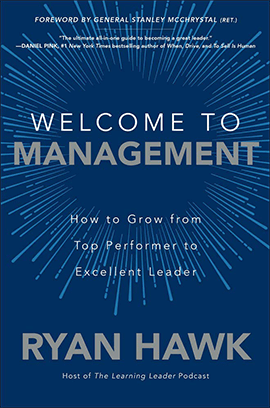 Publisher: McGraw-Hill Education
Publisher: McGraw-Hill Education
Year Published: 2020
Number of Pages: 240
Growing from a performer into a leader is the hardest transition anyone makes in a career, Ryan Hawk writes in his book, Welcome to Management.
He introduces the Peter Principle, and explains that generally, people are promoted into managerial positions because they excel at their current positions. However, the new role requires an entirely different set of skills. Whereas formerly, an employee may have been creating something (such as software), as a manager they’re no longer “doing,” but rather coaching or leading.
“Being promoted up the ranks is exciting, but unfortunately, the typical organization does an underwhelming job of preparing its new managers for success.”
“This book is for you and about you,” he writes. It aims to fill this training gap and provide much-needed coaching to new managers.
The writing is funny and sharp, and includes many lessons Hawk learned playing football in college and with the NFL.
The book starts by explaining that managers need to work on themselves first. It includes chapters on self-discipline, morning routines, curiosity and self-awareness. The rest of the book focuses on building and leading a team.
Hawk is host of the popular podcast, The Learning Leader Show, which is named by Inc. Magazine as one of top five leadership podcasts. He’s a former college and professional football player, and advises athletes at the NFL, NBA and NCAA.
Many devoted podcast fans read the book and find it’s helpful for managers at any stage of their career journey. It includes actionable advice, and lessons taken both from Hawk’s experience and those he picked up from interviews.
Bringing Up the Boss: Practical Lessons for New Managers by Rachel Pacheco
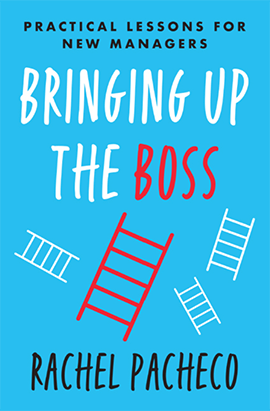 Publisher: Matt Holt
Publisher: Matt Holt
Year Published: 2021
Number of Pages: 304
According to Rachel Pacheco, author of Bringing Up the Boss, the career of a direct report hinges on the job performance of a manager.
“One of the dirty little secrets of managing is that it is a profoundly frustrating and disappointing job…the other dirty little secret of managing is that much of this disappointment is our own fault as manager.”
For example, oftentimes a team’s output is way below the manager’s expectations. This may have nothing to do with the capabilities of the team, however, but rather with a failure of the manager to communicate expectations.
Managing is serious work, she contends. A poor manager causes people to quit or be fired. But at the same time, she assures readers they’re sure to mess up, and encourages them to not take themselves too seriously. She hopes managers use her book as a guide to navigate the challenges of managing, which include giving feedback, coaching and hiring.
This is a fun book. Pacheco has a breezy writing style that incorporates humor, graphics and cartoons to illustrate lessons.
Plus, the information is clearly presented. Significant points are highlighted with bold text, and each chapter includes a TL; DR section with key points bulleted.
She organizes the book into three parts: managing an individual, a team and yourself. Chapters include intriguing and humorous titles such as, “Feedback is Like Underwear: It’s a Gift You Need, Maybe Not One You Want,” “Breaking Up is Hard to Do” and “The Meeting Paradox: We Hate Going, But We Still Want to Be Involved.”
Pacheco offers plenty of takeaway advice. The appendix includes templates on expectation-setting, onboarding, team norms, an individual development plan, as well as a list of powerful coaching questions.
Readers praise the book, and appreciate its humorous presentation of challenging lessons. They apply the lessons at work the very next day.
Pacheco is a researcher at The Wharton School and has served on the board for several digital and wellness startups. She also teaches courses to entrepreneurs at the University of Pennsylvania.
The First-Time Manager by Jim McCormick
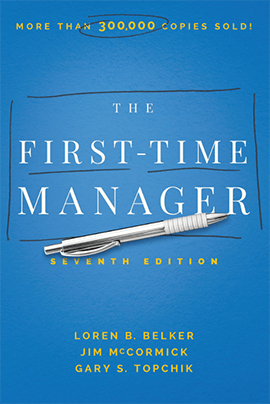 Publisher: AMACOM
Publisher: AMACOM
Year Published: 2018
Number of Pages: 306
According to Jim McCormick, author of The First-Time Manager, when anyone starts out as a manager, they encounter four types of employees: the jealous coworkers, the skeptics, the “yes-men” seeking to gain from the relationship, and the observers who reserve from passing judgement.
It’s tricky to contend with this crowd. “This book centers around two overarching messages: Be thoughtful in your actions and always conduct yourself with class. You will never regret either.”
McCormick believes that management is more art than science, and that working together, teams achieve far more than individuals.
Whatever problem you face as a new manager, within the 43 chapters in this book, McCormick has a kernel of wisdom to impart to you. Topics cover self-development, performance appraisals, risk management and team building.
He also includes helpful points: “If you want to be thought of as a brilliant manager, be an active listener” and “A good rule of thumb is not to have more direct reports than you can meet with once a week.”
The short chapters make it easy to plug through the book’s 300 pages.
McCormick is the former COO of the world’s fifth largest architecture firm. Currently, he’s the founder and president of Risk Intelligence, where he coaches business leaders.
Readers believe The First-Time Manager includes timeless advice applicable to any managerial position. It reduces legal headaches and creates higher retention and a happier workforce.
Conclusion
Even while new managers are thrilled with a promotion, it doesn’t take long for them to realize that managers don’t have it easy.
It’s a role that requires mastering so many soft skills that it’s nothing anyone can pull off in a day. Every new manager stumbles, underperforms and hits roadblocks. This is assured.
The good news is that plenty of managers have taken the time to share their expertise.
Even if you haven’t been formally trained as a manager, the guidance in these books for new managers offers a guiding light through any obstacle you face.
It’s always an adventure to do something new, and these books leave any new manager empowered to excel in the new role.
What’s your biggest challenge as a new manager?
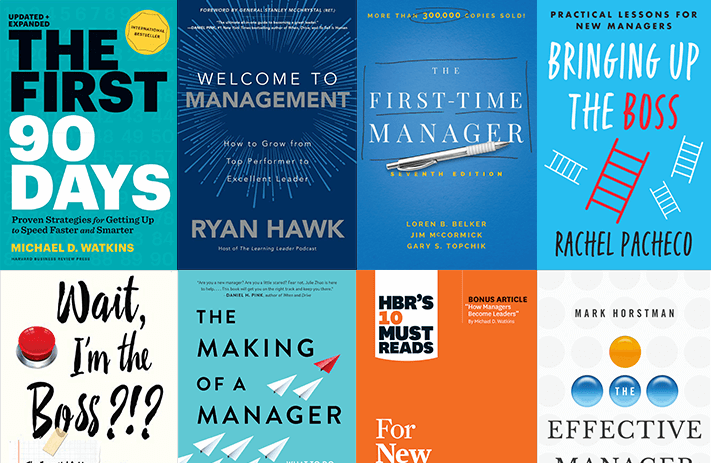











































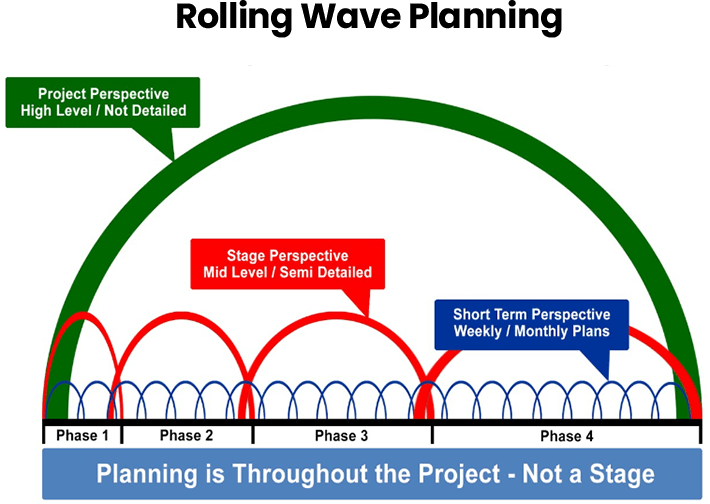



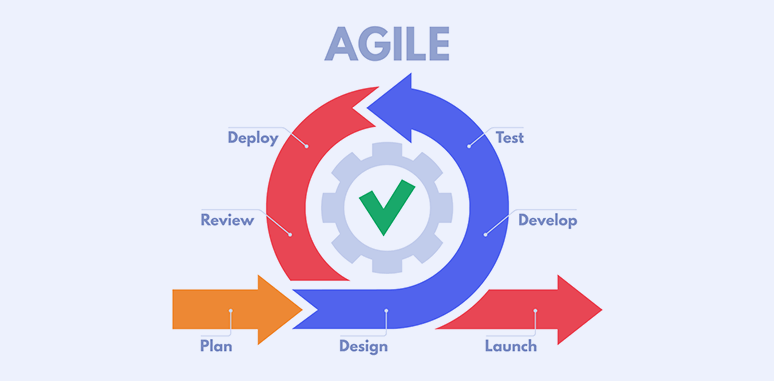

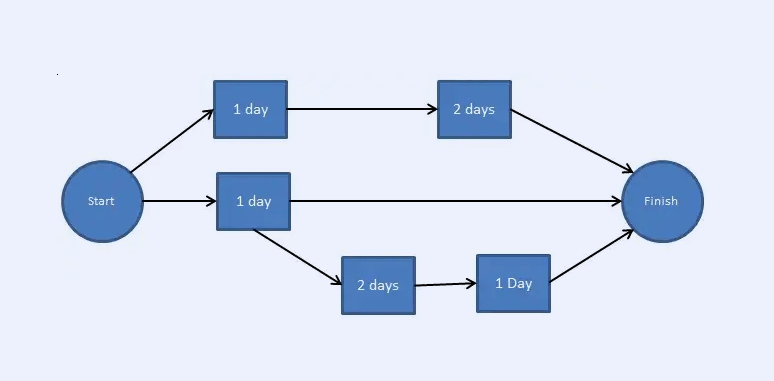
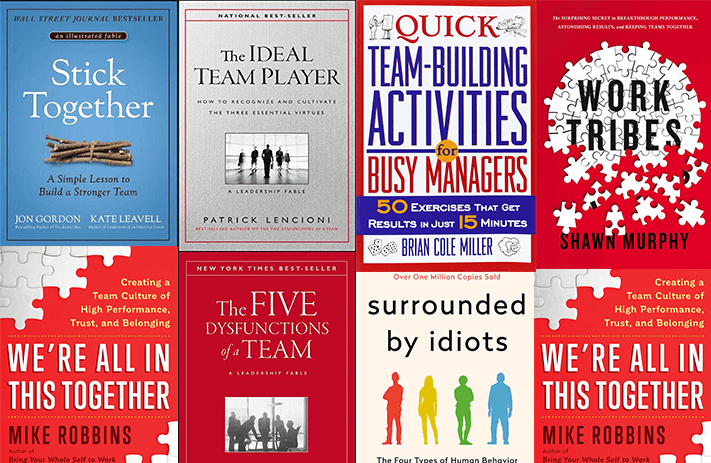
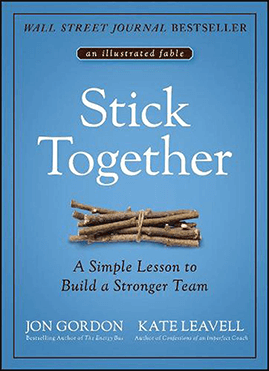 Publisher: Wiley
Publisher: Wiley Publisher: Essentials
Publisher: Essentials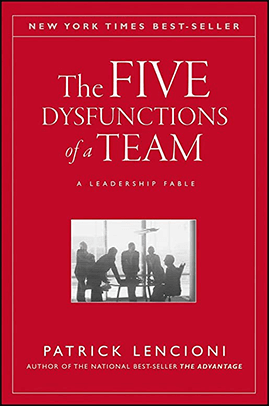 Publisher: Jossey-Bass
Publisher: Jossey-Bass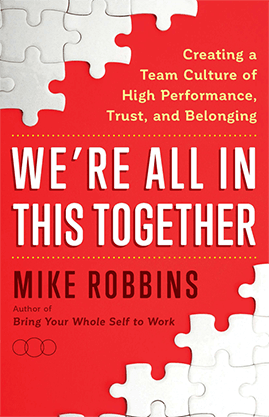 Publisher: Hay House Business
Publisher: Hay House Business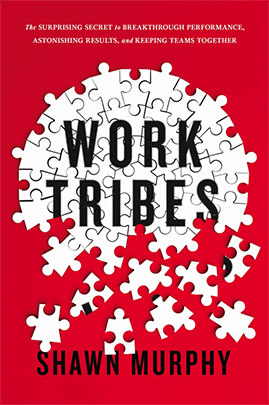 Publisher: Harper Collins
Publisher: Harper Collins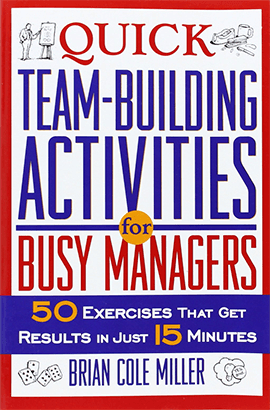 Publisher: AMACOM
Publisher: AMACOM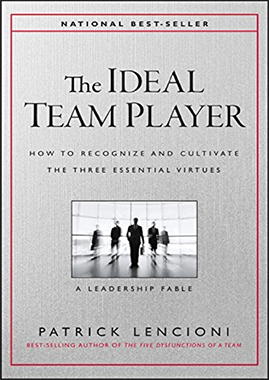 Publisher: Jossey-Bass
Publisher: Jossey-Bass